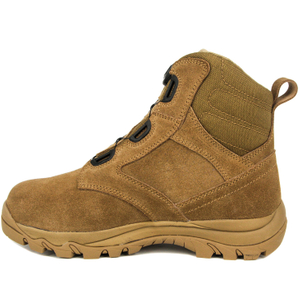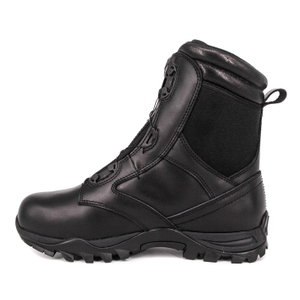Military boots are a vital part of any soldier’s uniform. They serve not only as protection for the feet but also provide support, comfort, and durability to withstand the harsh conditions of military environments. Whether it's a rugged battlefield, a hot desert, a cold jungle, or the icy arctic, military boots are designed to perform in some of the toughest terrains. But what exactly are military boots made of, and why are the materials used so important? In this article, we will break down the different materials that make up military boots, the function of each material, and how they contribute to the overall performance of the boots.
1. Upper Materials
The upper part of a military boot is the portion that wraps around your foot and ankle. This part is responsible for providing support and protection while ensuring the boot is breathable and comfortable. The materials used for the upper vary depending on the boot’s intended use. Common materials for military boot uppers include:
Leather (Flesh-out and Full-grain)
Leather has been used in military boots for centuries due to its durability and strength. It is one of the most common materials used for the upper part of military boots. There are two main types of leather used in military boots:
Flesh-out leather: This is leather that has the "flesh" side of the hide facing out. It is often used in the production of military boots because it is tough and resistant to abrasions, making it ideal for rough terrain. Flesh-out leather is known for its durability and water resistance.
Full-grain leather: Full-grain leather is the highest quality leather used for military boots. It is made from the entire hide, including the outermost layer. This type of leather is extremely durable, water-resistant, and can handle tough conditions without losing its shape. Full-grain leather boots often last longer but can be more expensive than other types.
Suede Leather
Suede is made from the underside of the leather hide, giving it a soft texture and a flexible feel. While not as durable as full-grain leather, suede is lightweight and breathable, making it a popular choice for boots designed for warmer climates or for those that require flexibility and comfort. Suede is also highly resistant to water, though not as much as full-grain leather.
Synthetic Leather
Synthetic leather is a man-made material designed to mimic real leather. It is often made from polyurethane (PU) or other polymers. While synthetic leather doesn’t offer the same durability as real leather, it can still provide a lightweight, cost-effective alternative. Military boots made from synthetic leather are typically cheaper and offer a similar level of comfort and flexibility.
Cordura Fabric
Cordura is a high-performance fabric made of nylon, often blended with cotton. This material is known for its exceptional strength, durability, and resistance to abrasions and tearing. Cordura is lightweight, breathable, and highly resistant to scuffs and abrasions, making it ideal for boots that require both flexibility and strength. Military boots made with Cordura fabric are often used in environments where flexibility and comfort are just as important as durability.
Waterproof Membranes (GORE-TEX)
Waterproofing is essential in military boots, especially for those who operate in wet conditions, such as jungles or rainy environments. One of the most common waterproof membranes used in military boots is GORE-TEX. GORE-TEX is a lightweight, breathable fabric that prevents water from entering the boot while allowing moisture (such as sweat) to escape. This keeps feet dry and comfortable, even in the wettest conditions. GORE-TEX is known for its durability and high performance in extreme environments.
2. Midsole Materials
The midsole is the section of the boot located just below the insole. It plays a critical role in providing comfort, cushioning, and support, as it helps to absorb shock from walking or running on hard surfaces. Different midsole materials offer different benefits, and choosing the right midsole material can make a big difference in the overall comfort of your boots.
Ethylene Vinyl Acetate (EVA)
EVA is one of the most common materials used in the midsoles of military boots. It’s lightweight, flexible, and provides good cushioning. EVA absorbs shock effectively, reducing the impact on the joints during long walks or marches. The material is also resistant to compression, meaning it retains its shape and cushioning properties over time. While EVA is a popular choice for comfort and shock absorption, it is not as durable as other materials like polyurethane.
Polyurethane (PU)
Polyurethane is a more durable material than EVA, and it is used in midsole construction to provide additional long-lasting support. PU offers better wear resistance, which is ideal for soldiers who spend long hours on their feet. While PU midsoles may be slightly heavier than EVA, they are often preferred for military boots because they last longer and can handle harsher environments.
Shanks (Steel or Composite)
Shanks are steel plates or composite materials embedded into the midsole of military boots. They provide additional support and protection to the arch of the foot, especially when carrying heavy gear or walking on uneven terrain. Shanks also help to keep the boot’s shape, preventing it from bending too much under pressure. Steel shanks are the most common type, but composite shanks (made from materials like fiberglass or plastic) are becoming increasingly popular due to their lighter weight and resistance to corrosion.
3. Outsole Materials
The outsole is the bottom part of the boot that comes into direct contact with the ground. It plays a crucial role in providing traction, stability, and protection against sharp objects like rocks or debris. The materials used in the outsole must be tough enough to endure rough terrain, wet conditions, and the weight of the soldier. Some of the most common outsole materials include:
Rubber
Rubber is the most commonly used material for military boot outsoles due to its excellent grip and flexibility. Rubber provides superior traction, helping soldiers maintain stability on wet or slippery surfaces. It is also highly resistant to wear and tear, which makes it perfect for rough environments. Many military boots use specialized rubber blends, such as Vibram, which offers enhanced grip and comfort.
Polyurethane (PU)
Some military boots are made with polyurethane outsoles, which offer a high level of durability and resistance to wear and tear. PU outsoles are also lightweight and provide good shock absorption, but they tend to be less grippy than rubber. PU outsoles are often found in boots designed for specific uses, such as indoor operations or environments that do not require extreme traction.
Conclusion
Military boots are crafted from a combination of materials designed to offer maximum protection, comfort, and durability. The upper materials, such as leather, suede, and Cordura fabric, provide the necessary support and resistance to harsh conditions. Midsole materials like EVA and polyurethane offer cushioning and comfort, while outsoles made from rubber provide essential traction and stability. Additionally, features such as insulation, toe protection, and waterproof membranes ensure that military boots are equipped to handle all types of environments, from scorching deserts to freezing tundras.
Choosing the right materials for military boots is crucial for both performance and safety, and the boots must be tailored to the specific needs of the soldier. Whether you're looking for boots with superior traction, waterproof protection, or the ultimate durability, understanding the materials used in military boots will help you make the best decision for your specific requirements.





















